► Lotus Emira takes on its biggest rivals
► Alpine A110 and 718 Cayman GTS 4.0 join the party
► Time for a Lotus reality check
We’ve had the glitzy reveal, the hype about Lotus’s big-money rebirth and the prototype drives. Now the talking stops: the Emira meets its stellar rivals.
Pre-flight briefing: Lotus Emira
Why is it here?
The last ever petrol Lotus, and the first truly new Lotus in yonks (Evija EV hypercar aside). It aims to be the most accessible Lotus possible, in terms of usability and with a price that’ll dip below £60k with the upcoming 2.0-litre turbo version. We loved the early validation prototype we tested on track – now for the combined acid tests of road and rivals.
Any clever stuff?
Posher switchgear, slick touchscreen infotainment, much easier access and visibility than the old Evora, intelligent predictive stability control so unobtrusive you barely know it’s there, and downforce-boosting layered aero surfaces within the bodywork.
Which version is this?
The priciest version: the First Edition V6, at £76k. Lower-spec V6s launching shortly will be nearer £70k, and next year’s AMG-engined four-cylinder just under £60k in base spec. This one’s a manual (a V6 auto is an option, although it’s a less-than-snappy torque converter). There are two suspension options: stiffer Sport or suppler Tour. This car is fitted with the latter. Choose from track-focused Michelin Cup 2s or this car’s all-rounder Goodyear F1s.
Read our Lotus Emira review
Pre-flight briefing: Alpine A110 S
Why is it here?
Since the Emira sits in junior supercar territory and the 718 Cayman 4.0 GTS is a GT4-lite without the wings and GT3-derived suspension, the Alpine fills the space below the two: a pure, essential sports car that feels like a more grown-up Elise. The Emira promises to be a Lotus without excuses: arguably Alpine made one five years earlier with this car.
Any clever stuff?
It’s as small and light as a modern car can be, with aluminium-intensive architecture: 96 per cent of the chassis and body is aluminium, and so is much of the 1.8-litre turbo engine, with its impressively high specific power output. This car’s optional aero kit promises 60kg of downforce over the front axle and more than 80kg at the rear at top speed (more than 170mph), although it does make the A110’s lines less dainty.
Which version is this?
The A110 S, with more power and much stiffer suspension than the standard A110 (and around £10k extra on the bottom line). Recent updates have given it even more power (296bhp to the old S’s 288bhp), that optional winged aero pack and (a bit) more interior storage space courtesy of a square rectangular bin moulded into the console between the seats. No dice if you want to carry a cup of coffee, though – there’s nowhere to put it.
Read our Alpine A110 review
Pre-flight briefing: Porsche 718 Cayman GTS 4.0
Why is it here?
There’s no better benchmark than a Cayman: it does so much so well, from the dreamlike stuff (malleable handling on the limit) to the mundane (genuinely practical luggage space, great visibility, easy to park, high-quality interior).
Any clever stuff?
Adaptive dampers are standard on the GTS, with two modes: Normal and Sport. They’re accessed via a manettino-style circular dial on the steering wheel, or buttons on the console. The Alpine and Emira use passive dampers. The Cayman rides relatively sweetly in Normal and is poised in Sport, if a little tough for UK back roads. The six-cylinder engine is capable of running on three cylinders under low load, to save fuel and reduce emissions.
Which version is this?
Base 718s start below £50k with a flat-four turbo; the £68k GTS 4.0 uses a mildly detuned version of the turbo-free flat-six found in the £80k Cayman GT4. This one’s a manual; PDK’s an option. If you prefer open-air sports cars, there’s a Boxster version which costs an extra £2k. There won’t be a convertible A110 or Emira. Ultimate Cayman is the hardcore GT4 RS, but that costs north of £100k.
Reality check
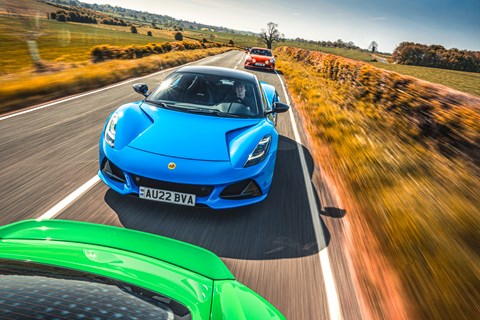
Excuse me,’ says the woman driving a Mercedes, pulling to a halt next to us. ‘Is this the new Lotus Emira? My boss has just ordered one.’
‘Sorry to interrupt,’ says the gent stepping out of his Range Rover, smartphone in hand. ‘Do you mind if I take a picture of the Emira? I’m thinking about joining the waiting list. My other car’s a Ferrari…’
‘Hope you don’t mind, I’d just like a closer look at the Lotus,’ says the passenger of an immaculate BMW E30 3-series. ‘I’ve ordered one in green with a tan interior. He’s further up the waiting list than me, though,’ he adds, nodding at his driver with a smile.
We’re on almost traffic-free country roads in the middle of nowhere. Perfect territory for testing the three best sports cars on sale today. And three of the very few cars we’ve seen so far today have contained people who’ve placed an order for an Emira – or know someone who has, or are thinking about it. Were we in any doubt before, surely this is proof: this new Lotus is A Big Deal.
First impressions are that it more than lives up to the hype. I’m on my own but I’ve the world’s chattiest steering for conversation, the octagonal wheel rim relaying all kinds of detail about the front tyres and the road surface they’re squidging into – and darting about over. That wheel needs a reasonably firm grip on a bumpy road as the Emira’s steering is more alive and excitedly prone to wandering than that of the average modern car. That’s not a criticism. This car is very much more alive, and exciting, than the average modern car.
Lotus offers buyers two suspension set-ups – supple Tour or firmer Sport, both with passive dampers – and this car is in the latter. It is firm, and more uncompromisingly so than I was expecting. But true to Lotus lore it’s still compliant. Lateral grip is phenomenal; braking and traction even more so. Each corner is dispatched with ‘Is that all you got?’ glee. You can brake later, carry more speed and get on the power earlier than your senses tell you really ought to be possible.
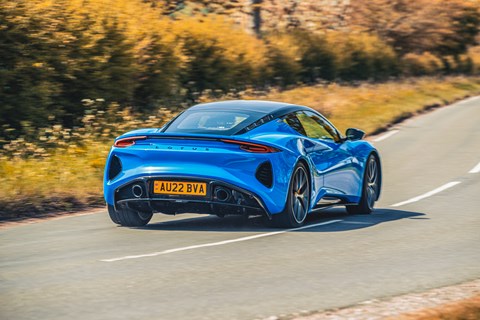
Unlike some very grippy, high-limit performance cars, however, the Emira doesn’t feel aloof or remote. It’s total immersion. You’re involved, and engaged, at any speed, low or high.
So it’s good, then. That’s a relief. There’s a lot of enthusiast emotion invested in this car. It’s the last Lotus petrol sports car and the first truly new Lotus in what feels like a generation, with the financial backing of industry behemoth Geely to bankroll its development.
‘A Lotus without excuses’ is how Ben Barry described the Emira back in August 2021. And Ben’s homing into view now in the Emira’s (beautifully shaped) mirrors in a machine that’s had sports car makers fumbling for excuse notes for a full decade and a half now: the Porsche Cayman. Its optional LMP1-inspired LED headlights look for all the world like crosshairs.
This one’s the 718 GTS 4.0-litre. Where lowlier 718s get flat-four turbos rich in torque but poor in aural satisfaction, the GTS enjoys a version of the naturally- aspirated flat-six in the 718 GT4. It’s on a par with the Lotus for price and, with close to 400bhp, power. This Emira, an early development car, is in First Edition spec, which for the V6 version means £76k. The 718 GTS starts at £68k but various options (Porsche doesn’t give you much in the way of kit as standard) lift this car’s price into the mid 70s.
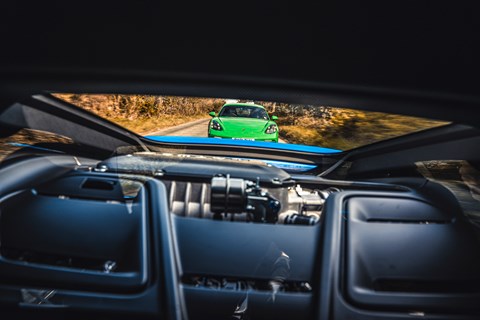
If all this feels a touch excessive, the unmistakable quartet of bauble-like lights bobbing along behind the Cayman are the ideal counterpoint. The Alpine A110 today occupies the vacuum Lotus has left behind with its move upmarket. A Lotus without excuses? You could argue Alpine (with early-stage partnership help from Caterham) did just that from scratch in 2017. This is an Alpine with a bit more of everything, however, the A110 S: more power, more grip (mechanically, thanks to wider tyres, and aerodynamically, with the optional aero pack), and much firmer suspension than the remarkably soft, smooth-riding regular A110. This is the updated S to boot, with power upped from 288 to 296bhp and slightly slicker touchscreen software. Whereas the regular A110 costs a whisker under 50 grand, the S is £10k pricier. And in this car’s case, with a generous smattering of options, more than £70k.
So two very different, very wonderful sports cars to stress-test the Emira. In terms of sheer presence, however, the Lotus has them both licked. Nothing turns heads like a Seneca Blue Emira. Every time we roll to a halt, even here in rural Lincolnshire, the Emira is suddenly mobbed by passers-by, farmhands and passing drivers. The Viper Green Porsche and Fire Orange Alpine might as well be invisible. In terms of its impact, guest tester Ben Hyland describes it as ‘a McLaren for £70k’, and it’s hard to disagree.
The Emira’s dramatic cab-forward, supercar-like proportions give it one drawback from a practicality point of view. The driver-forward package, together with the demands for crash structure, cooling and the clever layered aero surfacing at the front (boosting downforce by more visually neat means than the Alpine’s stuck-on spoilers) mean there’s no front boot.
If it might seem odd to be talking about boot space when we’ve three sublime sports cars to drive, please bear with me for a short while. Part of the Emira’s remit is to be the most accessible Lotus sports car possible, if not in terms of price (though the 2.0-litre version available next year is fractionally less than £60k in base spec) then in terms of physical accessibility and usability. One of the Cayman’s ace cards is its dual-boot practicality. It boasts a cavernous luggage compartment under the bonnet and an adequate secondary boot under a handily large tailgate at the rear.
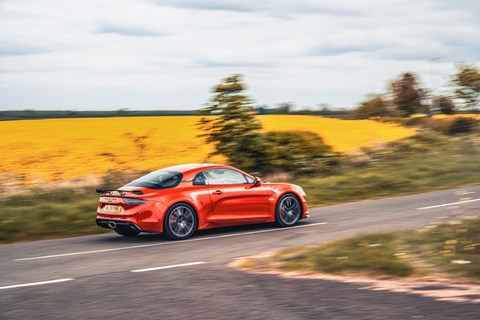
The Alpine too has a second boot up front but it’s very shallow (blame the double-wishbone front suspension – the Porsche uses more compact struts). Its rear boot is small, and accessed by a tiny, roundish manhole cover of a bootlid. If you’re carrying anything bulky, it’ll need to go in the passenger footwell. The Emira’s rear boot is much bigger, and could take two decent-sized squashy bags.
The A110 is the easiest car to get in and out of, however; just walk up to the big door aperture and you’re in, without quite noticing how you got there. The Porsche, too, is simple to hop in and out of, although you need to slide the seat back a touch for the most elegant dismount.
In the Emira you duck your shoulder under the roofline just as easily as in the Cayman and Alpine, but with that cab-forward package you must first stretch one leg a long way into the cabin, and then pick the other one over the high, broad sill that’s part of the chassis structure (although it’s far easier to do so than with an Evora or Exige). Once you’re in it’s actually enormously roomy, with plenty of space for two tall adults and epic legroom for the passenger. The only downside is pedal offset – they’re budged over towards the car’s centreline by the broad wheelarch wells, a fact that’s more noticeable in this left-hand-drive pre-production car.
And for interior storage, Emira is king here. There are doorbins, a slot for your smartphone, big dual-purpose cupholders/stowage pockets, a deep if narrow storage cavity under the centre armrest and a usable luggage shelf behind the front seats (where the Evora once offered a 2+2 option). The Porsche, too, offers a luggage rack above its flat engine and, while the Emira interior is, objectively speaking, the most practical, there’s something about the Porsche’s cabin that puts you immediately at ease. As does the way it drives.
There’s some kind of magic at work in the 718. Every car has a getting-to-know-you phase; a mile or two to tune yourself in. Every car except the 718. Within a few metres you feel as though you’ve been driving it for years. There’s something about its centre of mass, the way the whole car rotates around a point bang in the middle, and how malleable and predictable its handling is within, at and even beyond the limit. Balance is remarkably neutral, without much in the way of understeer, and the manual gearbox, although a little truculent from cold and with a rather long-travel, heavy clutch, is one of the very best when it’s warmed through. The gearing’s long – second is good for more than 80mph – and with shorter ratios it would feel faster still. But this loping gearing does enable you to enjoy wringing the engine out throughout the entirety of second gear, hearing its note morph from thrashy to soaring – like a soprano’s voice lifting above a hubbub of background conversation.
In the other two cars that ice-breaker ingratiation phase is short-lived too – they’re both so well sorted dynamically that you trust them intuitively. The Lotus, too, has a rather industrial sound at idle and low revs but that turns into a high-pitched and enjoyably raucous race-car-like yowl with revs. My ears call it a draw for the Best Soundtrack award.

The Alpine’s 1798cc turbocharged four doesn’t have the same big-capacity, multi-cylinder character. But it’s still a buzzy, vibrant and keenly responsive engine that suits the car’s compact, rally-inspired character. ‘It sounds angry, in a good way,’ comments Ben Barry. The Alpine is the narrowest car here (by a smidge, from the Cayman, although it feels narrower still) and its compact dimensions make it feel almost like a classic car to drive. It’s easy to thread down a narrow, rural B-road with brows, junctions and mid-corner ambushes by behind-schedule DPD drivers.
The Alpine’s confidence-inspiring, too: the brakes are simply mighty, even if they look less serious than the drilled discs on the other two cars. The Alpine’s near-300kg weight advantage comes to the fore here. Set-up is dramatically different from the regular A110, with 50 per cent stiffer springs and 100 per cent stiffer anti-roll bars, plus a lower ride height, and that does put the Alpine on a squarer footing with the other two in terms of body control. There’s a school of thought that the softer, slower, less expensive A110 makes more sense – a car that does its own thing, and is stronger for it. In chasing the Cayman, maybe the S loses a little of that modern-classic USP, and the handling bias is more toward understeer than the looser-limbed base A110.
Each of these cars has a touchscreen; none of them is brilliant. Not even the Lotus’s slick-looking set-up, which is awkward to use on the move, as are the touch-sensitive pads on the (resultantly chunky) steering-wheel spokes. But in terms of entertainment, not infotainment, the Emira is the most intense driving experience here. Almost to the point of being hard work in this Sport-set-up, manual car.
As tester CJ Hubbard notes, ‘There’s a real junior exotic feel to the Lotus. It’s the closest thing I can imagine to a modern supercar with a manual gearbox – and none of the modern supercar generation can offer that option. That could be a USP if you’re an ardent manual gearbox fan – but you might have to be with this one…’

The six-speed ’box isn’t flawless. It can be reluctant to go into reverse (a bugbear in the Evora, too) and you do need to concentrate to execute a perfect, smooth shift. But the sense of satisfaction when you do is immense, and this gearbox is far lighter in action than the unit in the prototype car we drove earlier this year.
The Emira to have might just be the base model arriving early next year, with its four-cylinder AMG engine and dual-clutch transmission. It’ll miss the V6’s howling engine note and extra layer of engagement, but it’ll be more versatile and no doubt every bit as thrilling.
In the meantime, should you spend your money on a 718 Cayman or an Alpine instead? This is not an easy call. But today’s polite passers-by can sleep easy. Regardless of this test’s verdict, they’ve spent their money on a sublime sports car.
Second opinion: Ben Hyland, co-founder of Hype Motorsport
You only need to look at the crowds of people flocking to the Lotus to see just what a draw it is. It really is like a supercar for under £80k, and it drives like one, too. Aspects of it frustrate; the way the gearbox can be reluctant to go into reverse isn’t something buyers of a £70k-plus car are likely to enjoy, and the shift action feels similar to the Elise I used to race. It’s still a Lotus in all of the right ways, but with a few of the drawbacks too. I’m actually more excited about the AMG-powered dual-clutch version on the way in a few months’ time. No doubt it’ll be silkier to drive and have just as much presence.
Second opinion: CJ Hubbard, head of Bauer Automotive Hub
Although the Porsche and Lotus ultimately deserve to come out on top, there’s so much about the Alpine that appeals. It feels immediately accessible and easy to get on with in ways that even the 718 GTS – with its slightly hairy-chested feel and occasionally recalcitrant gearbox – doesn’t. It’s more compact than the other cars, which lends itself well to UK roads, as does the chassis even on this firmer S version. Over bumps it handles its mass well because there’s less of it. It’s wonderfully small for a modern car, and I think it’s beautifully styled, too. I don’t even mind the carbon add-ons on this car.
Lotus Emira vs Cayman vs A110: the final reckoning
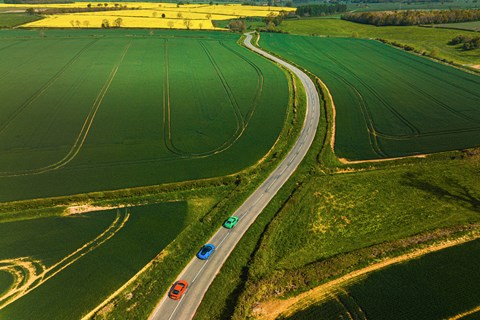
You don’t actually expect me to choose a winner, do you? Each of these three cars has a very different character, and they approach the brief in commendably different ways. Each is superb, and hugely desirable. What’s that? You’ve clicked on this page to find out the answer and it’s our job to make a judgement? Fair point. Here goes.
The Alpine in some ways is the most traditionally Lotus-like car here. It’s low in weight, small in size, a lesson in just-enough power and grip. The S version isn’t for everyone, especially at £10k more than the regular car, but if you value dynamics – or fancy the odd trackday – it does offer measurable dynamic gains over the beautifully compliant and chuckable standard car.
The Alpine’s a different proposition to the other two – more of a junior sports car than a borderline supercar. For many people, that could make it the most desirable car here. We wouldn’t argue with you. It’s wonderful, but it occupies a different space. And as much as its dainty proportions are a virtue, they also rob it of some practicality.
Now for the tricky bit. The Cayman has become such a go-to coupe sports car that it’s almost an obvious choice – almost, dare I say it, a boring choice. The Lotus is the more exciting car, both as an immersive driving experience and to be around. It has the aura of a supercar at half the price. It also marks a considerable step in ergonomic and interior usability for Lotus.
But the Porsche wins on points. Ben Barry sums it up neatly – it’s like an F1 driver who wins the championship by finishing on the podium in every race and grabbing the occasional victory here and there. To extend that analogy, the Lotus is a bit like a driver who wins five races in a row and frequently qualifies on pole but has a few too many DNFs.
By every measurable, rational metric – ease of use, visibility, perceived interior quality – plus the more subjective matter of handling satisfaction on the road, the Porsche takes the win today. Sports cars are anything but rational, though. They’re emotional purchases and the Emira is an emotional car through and through. The Cayman wins this test but if you’re one of the many who’ve ordered an Emira, you won’t be disappointed.
Lotus Emira vs Cayman vs A110: verdict

First place: Porsche 718 Cayman GTS 4.0
Now feeling its age but still so strong in so many areas
Second place: Lotus Emira First Edition V6
On sense of occasion and excitement it wins the battle. But the evergreen Cayman’s so well rounded it wins the war
Third place: Alpine A110 S
We all adore the A110, but it has less depth than the other two, and occupies a different territory on the sports-car map
Read more comparison tests by CAR magazine